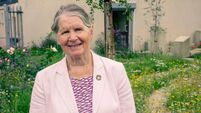Clodagh Finn: Amelia Curran, the Irish painter who immortalised poet Shelley

Amelia Curran's memorial in St Isadore's Church in Rome by the famous Irish sculptor John Hogan. Picture: courtesy of Laura McKenna
There is something very poignant in discovering that the only surviving image of 19th-century artist Amelia Curran is a sketch — more a doodle really — drawn by her younger sister, Sarah, the writer, poet, and musician, in the fly pages of her music book.
Sarah was just eight years old when she drew her sister in side profile, with loose curls and chignon, a tiny but touching tribute to a woman who would go on to paint the best-known portrait of poet Percy Bysshe Shelley which is now in the National Portrait Gallery in London.
Closer to home, Amelia Curran’s , a copy of one by Spanish Baroque painter Murillo, hangs in St John the Baptist Church in Blackrock, Co Dublin.
The explanatory note reads: “Here hangs Amelia Curran’s copy of Murillo’s Madonna del Boeme. She was the sister of Sarah Curran, the betrothed of Robert Emmet.”
HISTORY HUB
If you are interested in this article then no doubt you will enjoy exploring the various history collections and content in our history hub. Check it out HERE and happy reading
In Rome, the memorial to her in St Isidore’s Franciscan Church remembers her as the “most talented and virtuous daughter” of John Philpot Curran, a “true patriot [who] fearlessly pleaded the cause of his country”.
We do, however, get a sense of the woman herself from the man who commissioned it a few days after her death in September 1847, Lord Cloncurry.
“She was the most witty and agreeable woman I ever knew, full of talent and kindness; a musician, a painter and a writer. I loved and respected her sincerely,” he wrote in a letter asking the famous Irish sculptor John Hogan to honour her in marble.
While her father looms large in the inscription — it was the 19th century, after all — Hogan has included a harp, a palette, and brushes and a sheaf of papers, testament to the many talents of this overlooked Curran sister.
Like Sarah, her more famous sister, if she is mentioned at all, it is nearly always in relation to the men in her life or because of her connection to the Shelley family, but she deserves recognition in her own right.
When she moved to London in the early 1800s, the philosopher and novelist William Godwin introduced her to his circle which included poets, writers, and artists. She moved among them, visiting art galleries and exhibitions and attending lectures.
There are tantalising references to those days; snippets that make up a very interesting whole.
In 1811, for instance, she met Aaron Burr, the former vice-president of the US, best-remembered for killing US founding father Alexander Hamilton in a duel.
He said this of her: “[She has] all the genius and eloquence of her father, and the vivacity, the ingenuousness, and the sensibility of her sex and her country.”
When she moved to Rome, she lived in the city’s artistic centre, the via Sistina, and began to make her way as an artist by painting copies of the old masters, such as the one that survives in Dublin. She spoke fluent Italian and established a wide network that included artists and writers.
In 1819, she met Shelley, his wife Mary (author of ) and their family. She had met the poet before in London and much earlier, briefly in Dublin, when he visited the city — and the Curran household — in 1812 on a trip to promote Catholic emancipation.
In the three months they spent in Rome, they met frequently and she painted all of their portraits, including one of their little son William who died soon afterwards of malaria.
When it was rediscovered around this time of year in 1971, the art critic Bruce Arnold described it as an “important Irish painting”.
If Amelia Curran’s work was later forgotten, it was celebrated in her lifetime.
In 1820, she met Irish novelist Sydney Owenson (Lady Morgan), author of , who thought her “full of talent and intellect, pleasant, interesting, and original”.
The reason I know all of this is because I received a stream of emails after writing about Sarah Curran in this space a few weeks ago, including one containing the happy news that she will be the subject of Laura McKenna’s next book.
If the author of inhabits the world of Amelia Curran in the same way that she brought Tony Small, servant to Irish revolutionary Lord Edward Fitzgerald, back to life, it is safe to say that the Curran sisters will no longer be defined in relation to the men in their lives.
McKenna first became interested when she saw the Curran memorial at St Isidore’s Church in Rome where the writer’s brother, Fr Hugh McKenna, used to be guardian.

We already know a little about the Curran household because the head of it, John Philpot, was — and is — celebrated as an orator, wit, and the barrister who defended many United Irishmen against “corrupt judges and hostile juries”, to use the words on his daughter’s memorial.
He might be a colossus in public life but, in private, he ran a cold, rigid and “melancholy home”, to quote from Sarah’s description. The family home at the Priory in Rathfarnham was, of course, rocked to its core by the accidental death of Gertrude, who fell from a window when she was just 12 in 1792.
The loss, however, did nothing to soften Philpot Curran’s attitude when he discovered Sarah’s relationship with Robert Emmet. He threw her out of the house in the same way that the great public man (and serial adulterer) had forced his wife, also Sarah, out eight years before when she got pregnant in a relationship with another man.
It is interesting to see, too, that it was Amelia who tried to protect her younger sister by throwing the secret letters she got from Emmet into the fire when British soldiers searched the family home after the failed rebellion of 1803.
Little wonder both sisters were said to have bouts of melancholy, or depression as we might call it now, yet their creativity also flourished.
Sarah went on to marry and, sadly die very young, but Amelia struck out on her own, establishing herself as an artist at a time when it was unusual, and difficult, for a woman do so.
As Laura McKenna puts it: “She wanted to become a painter, but she also wanted to make her living by painting and she appears to have done so.”
There were commissions, including the most famous one of Shelley which Amelia herself declared unfinished. She was on the point of burning it but Mary Shelley, by then a widow, pleaded with her not to.
One of her paintings went as far as Newfoundland and the Murillo copy now in Blackrock was bought by Lord Cloncurry, of Blackrock, who donated it to the church when it opened in 1842.
Speaking of the church, Amelia later converted to Catholicism and there are many references suggesting that St John Henry Newman, newly proclaimed a doctor of the church, gave her funeral oration. It’s unlikely, though, says Laura McKenna as he was not in Rome at that time.
(On an aside, there are now 38 doctors of the church, 34 men and four women. Just saying.)
If there is one upside to the link with this famous man of the church, it is that Amelia Curran’s memory was kept alive.
Now, however, she is returning to the ether with a book in the pipeline. Can’t wait.














